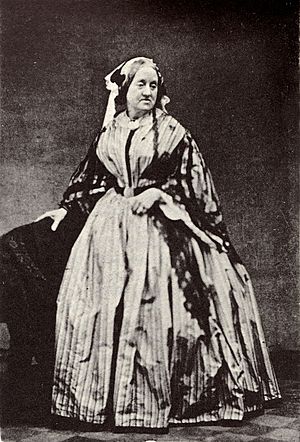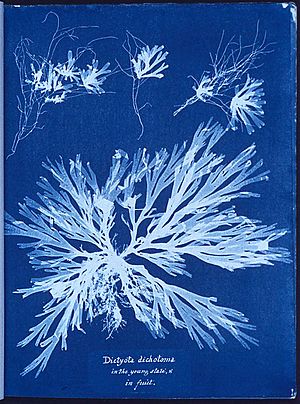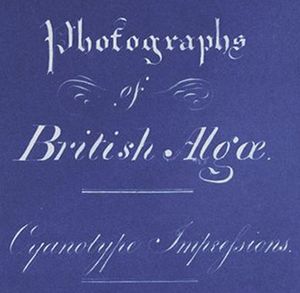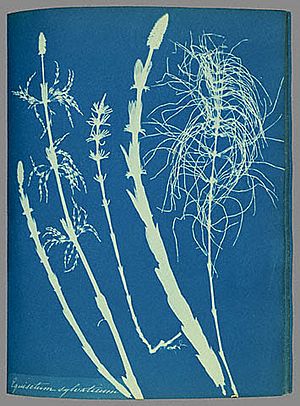Anna Atkins facts for kids
Quick facts for kids
Anna Atkins
|
|
|---|---|

Portrait from 1861
|
|
| Born | 16 March 1799 |
| Died | 9 June 1871 (aged 72) |
| Known for | Very early botanical photographs, 1843 book Photographs of British Algae: Cyanotype Impressions (1st book illustrated with photographic images) |
| Spouse(s) | John Pelly Atkins |
| Scientific career | |
| Fields | Botany, Photography |
| Influences | |
Anna Atkins (born Anna Children; 16 March 1799 – 9 June 1871) was an amazing English botanist and photographer. She is famous for being the first person to publish a book with actual photographic pictures inside. Some people even say she was the first woman ever to take a photograph!
Contents
Early Life and Learning
Anna Atkins was born in Tonbridge, England, in 1799. Sadly, her mother passed away when Anna was very young. Anna grew up very close to her father, John George Children. He was a well-known scientist who studied chemicals, minerals, and animals.
Because of her father, Anna got a really good science education, which was unusual for girls at that time. She was very talented at drawing. Her detailed drawings of shells were used in a book her father translated.
In 1825, Anna married John Pelly Atkins. He was a merchant and later helped build railways. They moved to Halstead, Kent, and did not have any children. Anna loved botany, which is the study of plants. She collected dried plants, which she later used in her special photographs. In 1839, she became a member of the London Botanical Society.
Discovering Photography
Anna Atkins's father and husband were friends with William Henry Fox Talbot, who was a pioneer in photography. Anna learned directly from Talbot about his new photography methods.
One method was "photogenic drawing." This is where you place an object directly onto special paper that reacts to light. When exposed to the sun, it creates an image of the object. She also learned about calotypes, another early photography process.
By 1841, Anna Atkins had her own camera. There's a friendly debate about who was the first female photographer: Anna Atkins or Constance Fox Talbot. Since no camera photos by either woman from that time have survived, it's a mystery that might never be solved!
Photographs of British Algae: Cyanotype Impressions
In 1842, a friend of Anna's, Sir John Herschel, invented a cool new photography process called cyanotype. This process creates images with a beautiful blue color.
Within a year, Anna Atkins started using the cyanotype process for her botany work. She focused on algae, especially seaweed. She made "photograms" by placing dried algae directly onto the cyanotype paper. The sunlight would then create a blue image of the plant.
In October 1843, Anna published the first part of her book, Photographs of British Algae: Cyanotype Impressions. She wanted to create pictures for another book about British algae. Even though her book was printed privately and had handwritten text, it is known as the very first book ever illustrated with photographic images!
About eight months later, another famous photography book, The Pencil of Nature by William Henry Fox Talbot, was released. That book was the first photography book sold to the public.
Anna Atkins created three volumes of Photographs of British Algae: Cyanotype Impressions between 1843 and 1853. Only about 17 copies of her book still exist today. You can find copies in famous places like the British Library in London and the New York Public Library.
Later Life and Other Works
Besides her famous algae book, Anna Atkins also wrote five novels between 1852 and 1863. Some of her book titles were The Perils of Fashion and Murder will Out: a story of real life.
In the 1850s, Anna worked with her friend Anne Dixon. They made at least three special albums of cyanotype photograms together. These included:
- Cyanotypes of British and Foreign Ferns (1853)
- Cyanotypes of British and Foreign Flowering Plants and Ferns (1854)
Anna kept all the algae, ferns, and other plants she used for her work. In 1865, she gave her entire collection to the British Museum.
Anna Atkins passed away in 1871 at the age of 72. She left behind an amazing legacy as a pioneer in both botany and photography.
See also
 In Spanish: Anna Atkins para niños
In Spanish: Anna Atkins para niños




